A.CLASSIFICATION
P.nudum is found to grow in India , and hence it is the only Indian species.
The Stele of rhizome is haplostelic or actinostelic type of protostele. Central xylem core is completely surrounded by the phloem.
Each mature synangium is 2-3 mm wide , 3 lobed and each lobed contains a spore sac , in which numerous spores present. Psilotum is homosporous i.e., it only produce one type of spores.
Divisions-Psilophyta
Class-Psilotopsida
Order-Psilotales
Family-Psilotaceae
Genus-Psilotum
The genus Psilotum is widely distributed in the tropical and sub tropical regions of both northern and southern hemisphere, (e.g., P.nudum and P.flaccidium). The plant is xerophytic in nature and grows in various habitats from very dry to moist place. They are also found to grow on tree ferns and plalms.
P.nudum is found to grow in India , and hence it is the only Indian species.
B. STRUCTURE OF THE SPOROPHYTE
1. EXTERNAL STRUCTURE:- The sporophyte i.e., the plant body is well differentiated into ----- a slender rootless rhizome and an aerial shoot.
Rhizome- The rhizome contains a mycorrhizal fungus and is covered with hair like rhizoids. The branching of the rhizome is dichotomous. Some of the dichotomy may become erect and develop into green aerial leafy shoot.
Aerial shoot- Aerial shoot are either pendent or erect. The branching of aerial shoot is dichotomous.
Leaves:- The aerial branches bears on the upper part, small, scale like appendages i.e., leaves, arranged in 2-3 rows.
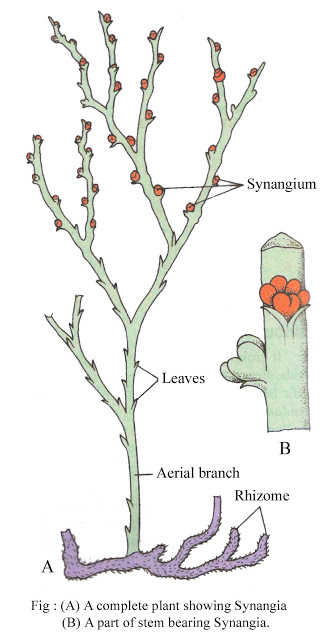 |
| Source Wikipedia |
2.INTERNAL STRUCTURE:-
a) T.S of aerial shoot:- The internal Structure of aerial shoot shows the following tissue systems-
Epidermis- Epidermis of aerial shoot is one celled in thickness with heavily cutinized outer wall.
The Epidermis is interrupted by the presence of stomata.
The Epidermis is interrupted by the presence of stomata.
Cortex- Cortex is broad and diffrentiated in to three regions-
a) Hypodermal outer cortex composed of chlorenchymatous cells, 2-5 layer thick,
b) Middle cortex composed of thick walled sclerenchymatous cells, 4-5 layer thick,and
c) Inner cortex composed of thin walled parenchymatous cells, containing ambendent starch grains. The innermost layer of cortex is single layered endodermis with casparian strips.
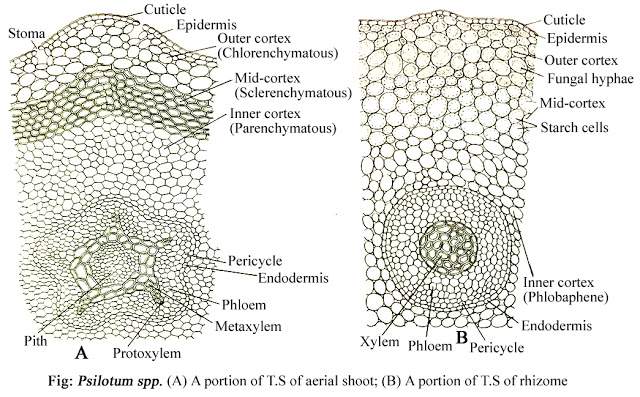 |
| Source Wikipedia |
In rhizome cortex is composed of only thing walled parenchymatous cells containing mycorrhizal fungus.
Stele- The Stele of aerial shoot is actinostelic protostele, with 5-6 xylem Rays. The xylem Rays are exarch. Phloem lies in the outer portion, covering the xylem Beneath the endodermis. Phloem cells are made up of thin walled cell elements and seive tubes.
The Stele of rhizome is haplostelic or actinostelic type of protostele. Central xylem core is completely surrounded by the phloem.
b) T.S of Leaf:- The T.S of leaf show a single layered of Epidermis. Stomata are absent in the epidermal layer.
Beneath the Epidermis is an undifferentiated chlorenchymatous mesophyll cells. There is no vascular tissue in the leaf of Psilotum.
Beneath the Epidermis is an undifferentiated chlorenchymatous mesophyll cells. There is no vascular tissue in the leaf of Psilotum.
 |
| Source Wikipedia |
C.REPRODUCTION
The sporophyte of the Psilotum reproduces both by Vagetative means and by production of spores-
1. Vagetative Reproduction- Vagetative Reproduction in Psilotum takes place by the formation of gamae. The gamae are developed in large number on the rhizome. The gemma may be germinates into new plant when it is still attached to the parent plant or when they fall suitable substratum after datachment.
2. Spore Formation- In Psilotum , the spores are formed in a specialized spore bearing structure , known as sporangia. The sporangia are borne triads on the vertical side of the appendages, i.e., leaf at the point of dichotomy and are slightly raised short stalk. The sporangia are fused with one another, and such group of sporangia is known as synangium.
Each mature synangium is 2-3 mm wide , 3 lobed and each lobed contains a spore sac , in which numerous spores present. Psilotum is homosporous i.e., it only produce one type of spores.
D.STRUCTURE OF THE GAMETOPHYTE
Spore is the first cell of the Gametophyte.
Each spore is bilaterally symaterical with outer delicate and thin reticulate wall. The spore germinates after about 4 months of liberation, and develops into a gametophytic plant body.
Spore is the first cell of the Gametophyte.
Each spore is bilaterally symaterical with outer delicate and thin reticulate wall. The spore germinates after about 4 months of liberation, and develops into a gametophytic plant body.
The gametophytic plant body is very small, brown in colour , sub-terranean and sporophytic in nature. The mature gameophyte is dichotomously or irregularly branched and is covered with dense, brown, hair-like rhizoids filled with mycorrhizal fungus.
1.Antheredia:- Antheredia begin to develop on the Gametophyte earlier than the archegonia. Each anthredium is a projected spherical body, covered by a single layer , lies numerous sperm mother cell, which metamorphse into numerous spiral, multiflagellate sperms, i.e., anthrezoids .
2.Archegonia:- The archegonia is shunken with short projecting neck, which break away at maturity. The neck consists of 4-5 cells long, and consists of 2 neck canal cell. The venter consists of one ventral canal cell and egg cell.
3. Fertilization:- At maturity the neck of the archegonium break, follow by the disintegrations of the neck canal cell, which leaves a passage for the entry of sperms. The sperm after liberation from the anthredium, makes it's way through the archegonial neck and finally reaches the egg. On reaching the egg, one sperm fuse with the egg to complete the fertilization.
As a result of fertilization , a diploid zygote 2n is formed , with the formation of zygote, diploid sporophytic generation begins.
1.Antheredia:- Antheredia begin to develop on the Gametophyte earlier than the archegonia. Each anthredium is a projected spherical body, covered by a single layer , lies numerous sperm mother cell, which metamorphse into numerous spiral, multiflagellate sperms, i.e., anthrezoids .
2.Archegonia:- The archegonia is shunken with short projecting neck, which break away at maturity. The neck consists of 4-5 cells long, and consists of 2 neck canal cell. The venter consists of one ventral canal cell and egg cell.
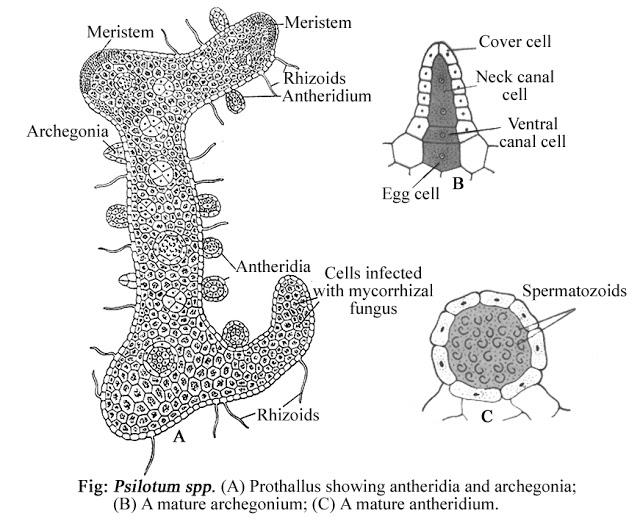 |
| Source Wikipedia |
3. Fertilization:- At maturity the neck of the archegonium break, follow by the disintegrations of the neck canal cell, which leaves a passage for the entry of sperms. The sperm after liberation from the anthredium, makes it's way through the archegonial neck and finally reaches the egg. On reaching the egg, one sperm fuse with the egg to complete the fertilization.
As a result of fertilization , a diploid zygote 2n is formed , with the formation of zygote, diploid sporophytic generation begins.
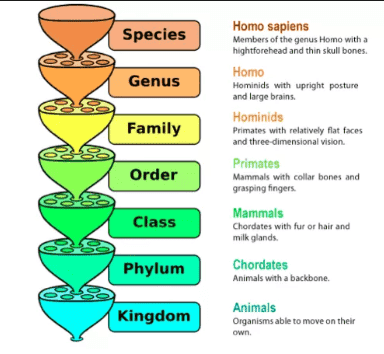

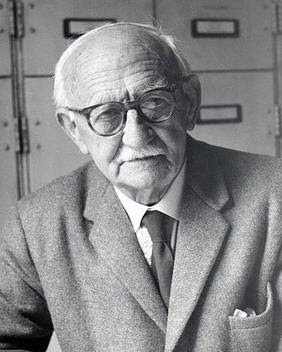


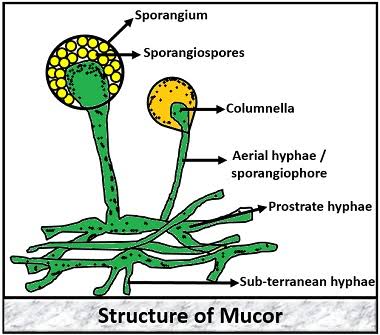









0 Comments
If you have any query let me know.